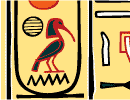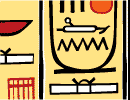The New York Times -- June 20, 1999
In an Egyptian Oasis City, Archeologists Uncover Necropolis With
10,000 Graves
By AGENCE FRANCE-PRESSE
 AWITI, Egypt -- Archeologists spent five years excavating an ancient
site at an oasis 200 miles southwest of Cairo, but it was not until a
guard's donkey sank into a grave there that the first 105 mummies were
found.
AWITI, Egypt -- Archeologists spent five years excavating an ancient
site at an oasis 200 miles southwest of Cairo, but it was not until a
guard's donkey sank into a grave there that the first 105 mummies were
found.
Researchers have since discovered that the site, in a
two-mile-square area within the city of Bawiti, contains a necropolis
from the Greco-Roman era with about 10,000 graves.
"This is the most important discovery in terms of quantity and
quality," said the excavation leader, Zahi Hawas, director of
antiquities at the Giza pyramids.
The first 105 mummies, bedecked in the metal of ancient gods, have
been found in four tombs. One of them, the remains of a woman with
salt-and-pepper hair, was covered in gold.
Another, the body of a man, bore a golden chest-covering decorated
with divine cobras and the falcon-headed god, Horus. The mask over the
mummy's hair was set off by a crown of laurels in colored plaster.
The upper body of a third mummy was covered in yellow papier-mâché
with colorful drawings of important gods.
The mummy seemed to stare mockingly at the living, with black onyx
pupils ringed with blue and set against the ivory white of its eyes.
"The wealth of design on the mummies makes up for the bare walls of
the tombs," Hawas said.
The site will not become a tourist attraction, he said.
"The mummies will stay at the site and will not be shown to the
public in order to preserve them as much as possible," Hawas said.
"They will be available only to experts studying the necropolis."
"Their eternal rest must be respected, not disrupted by eager
curiosity seekers," he added.
Inside the vaults carved into the rock, men and women lie side by
side. Sometimes children are found between their parents. They are
swathed in linen bands that together form colored diamond-like
designs.
"Each vault is probably the resting place of a single family,"
Hawas said. "We don't have a clue as to who they are, but their lavish
mummies show that they were wealthy dignitaries," he added.
"They provide countless details on mummification and religious life
during the time when the oasis was home to 500,000 people," he said,
adding that the population of Egypt during classical times was roughly
seven million.
"Earthenware jewelry, pottery and statuettes of professional
mourners lie near the bodies, showing that this area had a very
advanced civilization," Hawas said.





